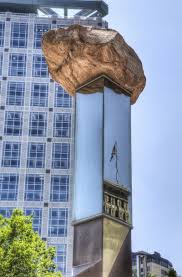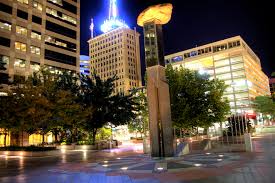“Asteroid Landed Softly” is a sundial and suggests the image of Southern Utah’s landscape. Many old European plazas have a clock tower to act as a landmark of the city. This piece carries the some tradition in which time is on element of space.
The sundial works in the following manner – through a slit in the tower a beam of sunlight is cost on the plaza floor. The beam acts as an arm of a clock, and hour (nine to two o’clock); every fifteen, twenty and thirty minutes are marked by stainless steel tubes. The hours are indicated by double tubes on which a prism is attached so that when sun beam falls on it, a small batch of colors is cast on the plaza. On the inclined granite slabs are engraved months of a year. When the top end of the sun beam touches the engravings, it marks the month. The farthest tip of the slab indicates the winter solstice while the middle end indicates the spring and autumn equinoxes, and the closest bottom tip marks the summer solstice. The slabs also show dates of Pioneer Day and Utah’s Statehood.
The sundial time, which is called “natural time” is based on the principle that noon is determined when the sun crosses the meridian (or the true south) of the particular location. Our watch, on the other hand, is based on a system called “real time” where the time zones start in Greenich, England. This system is basically human made convention. The natural time and real time coincides only at a longitudinal line where a time zone changes. Within times zones there are differences between the natural and real times. In addition we have daylight savings time, thus at some locations the difference between the two systems is nearly two hours. This piece tries to demonstrate this discrepancy or gap between the two systems and points to the question of what is natural and what is real. (A Roman is said to have complained, ”Let the gods damn the first man who invented the hours, the first man who set a sundial in this city! For our misfortune, he has chopped up the day into slices).
The magnificent Southern Utah landscape is a wonder of natural forces creating in many parts most unnatural rock formations. Many boulders are perched up in the air in the most precarious positions, such as Balanced Rock. This piece tries to capture the image of the Southern Utah with its use of red sandstone rock superimposed with the method of the surrealism painting of Rene Magritte. The rock, which might be a visitor or an asteroid from outer space, is balanced on a tower clad by reflective glass. Images of downtown buildings, sky and clouds are reflected on the glass and become a part of the sculpture. The lower portion of the tower is clad with raw copper sheets whose color will continue to change over many years. The working of a sundial is based on the rotation of the earth, and through this sundial and its movement of the sun beam, we can literally see and feel, the rotation of the earth. This rotation suggests an idea of wheel, thus various images of wheels borrowed from different cultures are depicted in the pattern of the pavement for the base of the sundial. They include icons of Judeo-Greek zodiacs, Native American’s medicine wheel, Ying-Yang of the Chinese, and twisting patterns of wind and water (and perhaps of galaxies).
Matsubayashi “hopes this sundial with its floating rock will trigger the observer’s mind to the basic scientific curiosity and artistic imagination in their most innocent beginning and to wonder about the mystery of natural forces, to ponder what is nature and reality, what is time and space. Or perhaps one can simply kill time by standing in front of it. Today many of us are being chased by time.”
This project was part of the Block 57 development / The Gallivan Center.
Artwork featured in header: Through the Safety Lens by Alexander Tylevich


